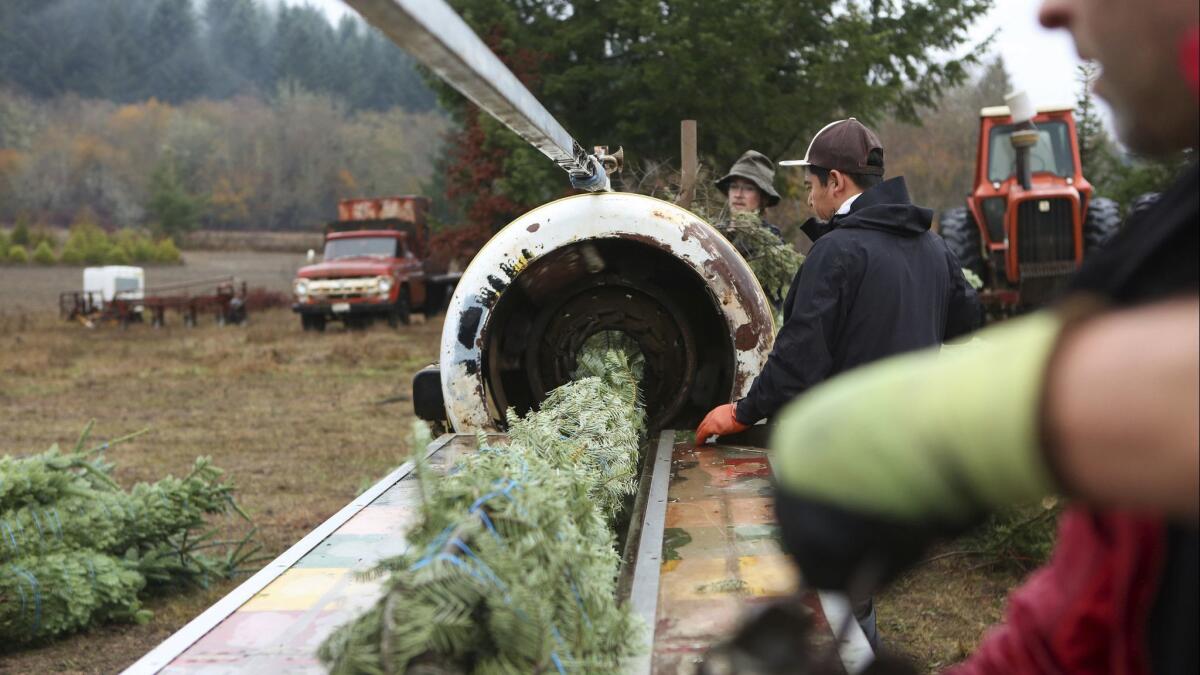Op-Ed: In 2018, is there such a thing as a guilt-free Christmas tree?

Thanksgiving is barely over, but the Christmas tree debate has already begun. We don’t argue politics in my family, but the tree discussion is always spirited. Big or small? Short needles or long? From Home Depot or a place that donates the proceeds to charity? My daughter would prefer a tree from a farm owned and operated by women. For my son, the money should definitely go to a good cause — otherwise two weeks of Christmas spirit is a complete waste. My husband just wants it to be cheap.
He grew up with a 2-foot-tall green plastic tree his mother pulled out every December and decorated with color-coordinated ornaments. He’s Jewish though, so his family gets a pass. I’ve always thought it was very enlightened of her to decorate in any remotely Christian way, but she said trees aren’t Christian, they’re pagan. She was right.
Evergreen branches were once upon a time brought indoors at the winter solstice to remind the pagans that spring would come. The Romans decorated fir trees with fruit and candles to celebrate the god Saturn in December. Christians adopted the tree in the middle ages and hung it upside down from the ceiling thinking that best represented the holy trinity. When I married my husband, I said I would light the menorah and fry latkes for Hanukkah, but I absolutely had to have a Christmas tree. He was fine with that.
The best, most ecological and ethical answer is not to have a Christmas tree at all.
This year I’m hyperaware of the politics of everything, including Christmas trees. I want to do what’s right. Which is more ecological, real or plastic?
The Addis Brush Factory, a toilet brush manufacturer, made the first plastic tree in the 1930s from toilet brush bristles. It was billed as convenient and clean despite the fact that plastic in those days was filled with lead. Now the polyvinyl chloride is lead free, petroleum derived and nonbiodegradable. A plastic tree’s average life span is five to seven years; then it will spend the next 1,000 Christmases in a landfill.
So what about real trees? They’re a crop, like wheat or soybeans. They’re often grown on steep hillsides, land not suitable for other plantings. According to the University of Illinois, 93% of Americans recycle their trees, turning them into valuable mulch. And for every one tree purchased, three are usually planted.
But a real tree’s not guilt free. In order to keep up with the demand for the 25 million Christmas trees sold every year, the trees have to be grown quickly using herbicides, pesticides and fertilizers. According to the National Christmas Tree Assn., tree farms employ 100,000 workers. That’s good. On the other hand, are these workers exposed to all those chemicals? I’ve also read that tree farms create a rich environment for woodland creatures, but with those pesticides in the soil, how much of an animal wonderland can it be?
The best, most ecological and ethical answer is not to have a tree at all. I have friends who decorate a wooden chair. Another friend’s sister hangs lights and ornaments on a skeleton she happens to have. Cat towers are popular tree substitutes on Pinterest, along with ladders painted green and pyramids of books and even repurposed soda bottles.
My son gave me a spray can of “pine scent,” so I can have that special tree smell whatever we decide. But it’s not the same. It’s not Christmas without the sound of my husband swearing as he maneuvers the trunk into the old metal stand. We have to struggle to make the tree straight as we discreetly tie it to the bookcase so it won’t fall over. And what would the new year be without vacuuming up needles until Valentine’s Day?
The tree decision is obviously not just about the tree. It’s the ritual, the box of ornaments from my childhood that I inherited when my mom died. She was single with three kids on a schoolteacher’s salary and the presents might have been few, but we always had a tree. We drank hot chocolate and ate popcorn while we decorated it. It was as close to a Hallmark moment as it ever got in my family. A tree means Christmas to me and year after year I’ve done what I can to make it significant for my kids as well.
Enter the Fray: First takes on the news of the minute from L.A. Times Opinion »
One year — pre-internet — I read in a magazine about a “cut your own” tree farm. We drove to Van Nuys from Silver Lake with our kids, 4 and 7 years old, our camera ready to take adorable California “winter” pictures. I even brought them mittens to wear with their shorts and T-shirts. It was 85 degrees, the trees looked dry and sick, and the “farm” was in the median of a busy road under the power lines. Another year we bought a living tree. Living trees are expensive, so it was tiny. We put three ornaments on it and propped the angel that usually goes on the top beside it. By the end of the holiday, it was drooping like the iconic Charlie Brown tree. We followed through: We planted it, watered it and it was dead by February.
Now the kids are grown, and we have to add to the tree discussion a planning session to make sure everyone can be home to decorate. I have rated their boyfriends and girlfriends by how they participate. One sat on the couch reading while we trimmed the tree, a big black mark in my book.
So far, the 2018 tree election remains undecided. Still on the ballot: A “tree” made out of scavenged lumber. One that benefits firefighters and fire victims. And anything that costs a fortune. I’ve decided what’s “right” this year is compromise.
As long as the angel fits on top, it works for me.
Diana Wagman is a contributing writer to Opinion.
Follow the Opinion section on Twitter @latimesopinion and Facebook.
More to Read
A cure for the common opinion
Get thought-provoking perspectives with our weekly newsletter.
You may occasionally receive promotional content from the Los Angeles Times.










